
The Boston Fire Museum
While I was writing the prequel for the Banished Saga, Love’s First Flames, I needed to research how fires were fought in Boston. Thus, I visited the Boston Fire Museum one Saturday morning and learned about fire fighting through the years. I had learned some information about the system and firefighters in the wonderful book A City So Grand: The Rise of An American Metropolis: Boston 1850-1900 by Stephen Puleo, but I needed more specific information about how a fire would have been fought in the 1880’s.
When I arrived, I was met by a guide eager to walk me through fire fighting since the colonial period. While I was conducting research, most people at the museum that day were there with their children, hoping to get on one of the trucks to ring the bell on a fire truck and take photos.
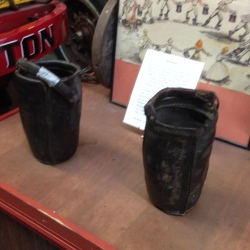
Buckets used in Colonial Boston to fight fires.
In the colonial period, all houses were required to keep two buckets by the front door. When the fire bell sounded, they had to rush out to the well where a line would form a bucket brigade. In 1782, Thayer (a student of Paul Revere) made a hand pump that was hand carried to fires. The buckets were still needed as that was how the pump was filled with water. This was considered the first fire engine.
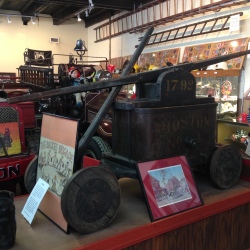
This Thayer pump is from 1792. It was filled with buckets of water and was a hand pumped fire engine. It was one of the first fire engines in Boston.
Up until 1859, Boston had what I would term a “pay for service” model for fire fighting. Men from the different fire fighting groups in the neighborhoods would visit the residents in the neighborhood once a year and sell a policy for their fire fighting service in the unlikely event their services were needed. If you purchased their aid, you’d put a marker in your doorway showing who was responsible to fight the fire. If a fire were to break out in your house, all of the different fire fighting groups would arrive, but the only ones who would fight the fire would be the ones whose emblem was over your doorway. The others would call out disparaging comments as the fire raged, never helping to fight the fire. If you’d not purchased any coverage for the year, you’d be able to buy it at that moment, but at a much greater price. If you couldn’t or wouldn’t buy coverage, they would stand and watch your home burn.
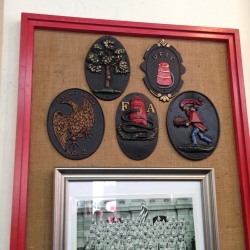
Fire emblems you'd hang over your door to indicate who was protecting you in case of a fire
Thus, in 1859, Boston re-organized the Boston Fire Department and did away with the neighborhood fire fighting groups and standardized the fire fighting efforts throughout the city. The necessity of purchasing an emblem or seal was no longer needed. My guide told me that it was a wild time to be a fire fighter as the men who had been part of the volunteer groups were disgruntled that they’d been disbanded and actively vandalized the equipment.
In the mid 1800’s another hand pump was used that required a vast number of men to man it. 20 to 25 men at a time were required to propel the water through the hoses. Firemen grabbed onto metal bars on either side of the pump and rocked the bar up and down to propel the water through the hose. It was exhausting work and men would only be able to do it for 3-5 minutes before needing a break. It required a group of 80-100 men, taking turns, to man it during a fire. Bystanders often joined in to help power the pump.
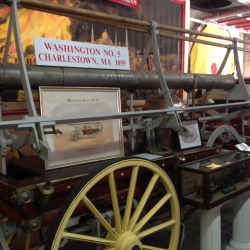
Hand pump requiring 20 or more men working in tandem to make it work.
In the 1860’s, steam powered pumps were introduced to the fire department. These were larger pumps and were pulled by horses to the fire. Eight to ten firefighters would hang off the side of the pump, waiting to reach the fire and jump down to battle the blaze. A fire fighter in the fire station was required to ensure that the correct steam pressure was maintained throughout the day, every day. He kept an hourly log of the steam pressure. If the pressure was incorrect, he would lose his position as they had to be prepared at any moment for a fire.
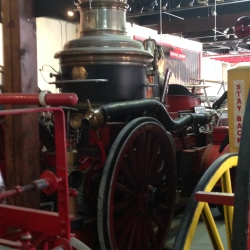
This is the type of steam powered fire pump that would have been used in the 1880's, the time of Love's First Flames.
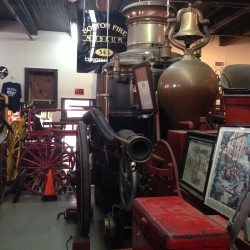
Another view of the steam fire engine
This is the type of fire engine that would have been used in Love’s First Flames.
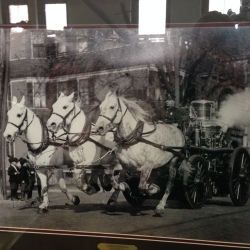
Steam powered fire pump pulled by horses
I greatly enjoyed my visit to the Boston Fire Museum and would recommend a visit if you are in Boston and have the opportunity to visit.
*****
The prequel to the Banished Saga is now available at all e-book major retailers for free! I hope you enjoy it and please consider leaving a review as reviews help others decide to take a chance on a new author.









